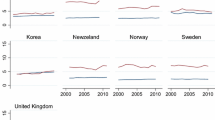Abstract
The few studies that have examined the wage impact of education across the earning distribution have focused on high-income countries and show education to be more profitable at the top of the distribution. The implication is that education may increase inequality. Extending the analysis to 16 East Asian and Latin American countries, in Latin America we observe a pattern similar to that of Europe/North America (increasing wage effects), while in East Asia the wage effects are predominantly decreasing by earnings quantile. However, once the analysis is performed separately for the public and the private sector, it is revealed that the strongly decreasing impact of schooling on earnings in the public sectors of East Asian countries is responsible for the overall observed decreasing pattern, while the impact of schooling on earnings in the private sectors of these countries is non-decreasing.
Similar content being viewed by others
References
Borjas G (2002) The wage structure and the earnings of workers in the public sector. In: Donahue J, Nye J (eds) For the people: can we fix public sector service?. Brooking Institution Press, Washington, pp 29–54
Buchinsky M (1998) The dynamics of changes in the female wage distribution in the USA: a quantile regression approach. J Econom 13: 1–30
Budria S (2006) Schooling and the Distribution of wages in the european private and public sectors. MPRA paper No. 90 (September)
Budria S, Pereira P (2005) Educational qualifications and wage inequality: evidence from Europe. IZA Discussion Paper No. 1763
Girma S, Kedir A (2005) Heterogeneity in returns to schooling: econometric evidence from Ethiopia. J Dev Stud 41(8): 1405–1416
Hyder A (2007) Wage differentials, rate of return to education and occupational wage share in the labor market of Pakistan. MPRA paper No. 2224 (March)
Hyder A, Reilly B (2005) The public sector pay gap in Pakistan: a quantile regression analysis. PRUS Working Paper no. 33
Koenker R, Bassett G (1978) Regression quantiles. Econometrica 50: 43–61
Martins PS, Pereira PT (2004) Does education reduce wage inequality? Quantile regression evidence from 16 European countries. Labour Econ 11: 355–371
Mueller RE (1998) Public-private sector wage differentials in Canada: Evidence from quantile regressions. Econ Lett 60: 229–235
Mwabu G, Schultz TP (1996) Education returns across quantiles of the wage function. Am Econ Rev 86: 335–339
Poterba JM, Rueben KS (1994) The distribution of public sector wage premia: new evidence using quantile regression methods. NBER Working Paper No. 4734
Psacharopoulos G (1979) On the weak vs strong version of the screening hypothesis. Econ Lett 4: 181–185
Skyt-Nielsen H, Rosholm M (2001) The public-private sector wage gap in Zambia in the 1990s: a quantile regression approach. Empir Econ 26: 169–182
Author information
Authors and Affiliations
Corresponding author
Rights and permissions
About this article
Cite this article
Patrinos, H.A., Ridao-Cano, C. & Sakellariou, C. A note on schooling and wage inequality in the public and private sector. Empir Econ 37, 383–392 (2009). https://doi.org/10.1007/s00181-008-0236-8
Received:
Accepted:
Published:
Issue Date:
DOI: https://doi.org/10.1007/s00181-008-0236-8




